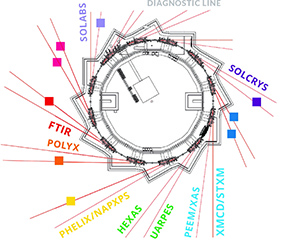 Web Content Display
Web Content Display
SOLARIS centre
 Web Content Display
Web Content Display
New beamlines at SOLARIS

Environmental protection, nanotechnology, diagnosis of diseases, and even samples of cosmic dust – these are only some of directions in research that will be performed soon thanks to the decision of the Ministry of Science and Higher Education to finance the construction of two new beamlines and an end station at the SOLARIS synchrotron in Kraków.
The new research infrastructure, eagerly awaited by the Polish scientific community, includes:
- an infrared beamline (FTIR)
- a beamline for multimodal X-ray imaging (POLYX)
- a scanning transmission X-ray microscope (STXM).
The main research conducted on the FTIR beamline will focus on biomedical aspects, from in vitro (conducted on cell cultures in laboratory conditions) to ex vivo experiments (on tissues or cells collected from living bodies), in the range of basic research, developing new analytical technologies and diagnostics.
The use of this unique source of infrared radiation provides unlimited opportunities for the analysis of composition and molecular structure and imaging of these features at the micro- and even nano-metric level. An example of such imaging is the molecular description of atherosclerotic lesions in heart valves, detection of the early stages of cancer, and identification of markers of inflammatory state of cells. These studies are especially crucial considering that both circulatory system and cancer diseases are the most common causes of death in Poland.
The new infrastructure will also allow for the study of photochemical and photophysical processes which take place in the environment or which are essential for the improvement of its protection, as well as processes involved in the degradation of works of art. Current scientific interest is also focused on nanomaterials used for the storage and processing of energy, and the design of biosensors and nanocarriers of pharmacologically active substances. The aim of these studies is in line with the research priorities of the National Research Programme for the areas of Diseases of civilisation, New and regenerative medicines, Modern materials technologies, and New energy technologies.
The scientists responsible for the coordination of the project are prof. Wojciech M. Kwiatekfrom the Institute of Nuclear Physics of the Polish Academy of Sciences (PAN) and dr hab. Kamilla Małek from the Jagiellonian University.
A further infrastructure investment planned for the SOLARIS Centre is the beamline for multimodal X-ray imaging (POLYX). For research purposes, an intense beam of hard X-rays generated by the SOLARIS synchrotron will be used. The POLYX beamline will accommodate several research techniques, including X-ray fluorescence microscopy, X-ray microtomography, X-ray absorption spectromicroscopy, and X-ray microdiffraction.
The new experimental beamline will provide researchers from various fields with broad opportunities for applications. Its interdisciplinary nature will enable analysis of new materials for science and industry, research in environmental protection and biology, as well as research in the area of cultural heritage. It will also enable research work in the field of geology as well as finding potential application in forensic science for crime scene investigations.
Important applications for POLYX will be, as in the case of the FTIR beamline, studies of pathogenesis and progress of diseases. Experiments conducted in these areas so far at other European synchrotrons have shown that research methods based on X-ray fluorescence may be extremely helpful in the investigations of pathogenesis of nervous system diseases such as epilepsy, Parkinson’s disease or brain tumours, as well as the mechanisms of action of drugs and therapies used for their treatment. The possible applications of X-ray fluorescence microscopy also include research on the treatment of obesity.
The operating coordinator responsible for the POLYX programme will be dr hab. Paweł Korecki from the Jagiellonian University. The AGH University of Science and Technology will be represented in the POLYX team by dr hab. inż. Joanna Chwiej and dr inż. Paweł Wróbel.
The third project to be implemented in the coming years at the SOLARIS Centre will be the construction of a scanning transmission X-ray microscope (STXM). This will provide an alternative end station on the XMCD beamline, which is currently under construction. The scanning X-ray microscope is the most universal type of X-ray microscope and nearly every modern synchrotron either already features such a device, or is planning or currently building at least one such device. This is not surprising as the research potential of this type of microscope is extremely broad, and involves strategic areas such as new materials and environmental protection. Examples of such research include research on electrode materials for lithium batteries, studies of polymers, and environmental studies. In many countries, arsenic pollution of water sources is a major problem. Using STXM microscopy, bacteria which have the potential to extract arsenic can be studied. Samples of comet dust particles and interplanetary dust have also been studied using STXM microscopy at Advanced Light Source in the United States.
The leader of the microscope construction project is dr Tolek Tyliszczak, who for 30 years worked at the American ALS synchrotron at Berkeley as well as at other synchrotrons around the world, constructing X-ray scanning microscopy end stations.
“Both the beamlines and the end stations are projects which have been prepared with the support of several research institutions in Poland and abroad,” stresses prof. Marek Stankiewicz, director of the SOLARIS Centre. “We are pleased that the synchrotron brings together scientists and institutions not only to conduct research, but also to cooperate in creating a research infrastructure.”
The FTIR and POLYX beamlines and the STXM end station will be constructed at the SOLARIS Centre by 2022, strengthening and expanding the research potential of the Polish synchrotron. The currently operating beamlines (PEEM/XAS and UARPES) and the newly constructed ones (PHELIX and XMCD) currently make use of only a small part of its potential.
The purchase of equipment and the installation of the two beamlines and the end station comprise a total investment value of nearly 27 million PLN.


